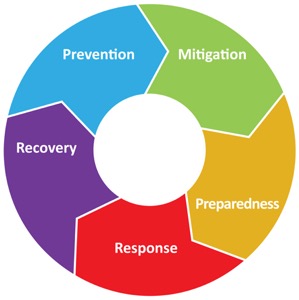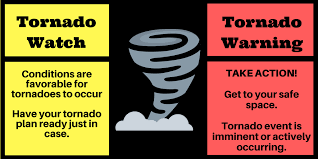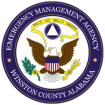EMERGENCY MANAGEMENT
Mission Statement
The Mission of the Winston County Emergency Management Agency is to provide a comprehensive and integrated emergency management system that coordinates community resources to reduce the loss of live, property and the environment through prevention, preparedness, response, recovery and mitigation from all natural and man made hazards by utilizing an all hazards approach,while providing leadership, assistance, and support to regional, state and local entities
Winston County Emergency Management Agency will build, sustain and coordinate the resources of the Federal, State, local governments, non-governmental organizations and the private sector to effectively meet the challenges faced during a disaster emergency.
FIVE PHASES OF EMERGENCY MANAGEMENT

PREVENTION
Prevention focuses on preventing human hazards, primarily from potential natural disasters or terrorist (both physical and biological) attacks. Preventive measures are designed to provide more permanent protection from disasters; however, not all disasters can be prevented. The risk of loss of life and injury can be limited with good evacuation plans, environmental planning and design standards.

PREPAREDNESS
Preparedness is a continuous cycle of planning, organizing, training, equipping, exercising, evaluating, and taking corrective action. Training and exercising plans is the cornerstone of preparedness which focuses on readiness to respond to all-hazards incidents and emergencies.

RESPONSE
Response is comprised of the coordination and management of resources (including personnel, equipment, and supplies) utilizing the Incident Command System in an all-hazards approach; and measures taken for life/property/environmental safety. The response phase is a reaction to the occurrence of a catastrophic disaster or emergency.

RECOVERY
Recovery consists of those activities that continue beyond the emergency period to restore critical community functions and begin to manage stabilization efforts. The recovery phase begins immediately after the threat to human life has subsided. The goal of the recovery phase is to bring the affected area back to some degree of normalcy.

MITIGATION
Mitigation is the effort to reduce loss of life and property by lessening the impact of disasters and emergencies. Mitigation involves structural and non-structural measures taken to limit the impact of disasters and emergencies. Structural mitigation actions change the characteristics of buildings or the environment; examples include flood control projects, raising building elevations, and clearing areas around structures. Non-structural mitigation most often entails adopting or changing building codes.

WINSTON COUNTY IS A RECOGNIZED STORM READY COUNTY
NOAA's National Weather Service in 2018 has recognized Winston County as a StormReady® county. The Storm Ready program helps community leaders and residents prepare for hazardous weather and flooding. Storm Ready sites have made a strong commitment to implement plans and resources in an effort to save lives and protect property when severe weather strikes.
Winston County Emergency Management has taken proactive steps to plan and prepare for weather impacts in an effort to help build a Weather-Ready Nation, through the National Weather Service.
The nationwide community preparedness program uses a grassroots approach to help communities and organizations develop plans to handle local severe weather and flooding threats. The voluntary program started in 1999. There are now more and more Storm Ready communities across the country working to build a Weather-Ready Nation.
To be recognized as StormReady, an organization must:
Have access to a 24-hour warning point and an emergency operations center;
Have more than one way to receive severe weather forecasts and warnings and to alert the public;
Monitor local weather conditions;
Promote the importance of public readiness through community seminars;
Develop a formal hazardous weather plan and hold emergency exercises.
The Storm Ready recognition will be in effect for three years then Winston County Emergency Management will go through a renewal process.

How Is a Tornado Watch Different From a Tornado Warning?
The difference between a tornado watch and a tornado warning means the difference between taking action or taking precautions. A watch means that conditions are favorable for a tornado to occur. A warning means that a tornado has been seen or picked up by radar. A warning requires you to take shelter and brace for a potential tornado.
Common Zones for Tornados
There are two general zones in the U.S. that are common tornado locations: Tornado Alley and Dixie Alley.
Tornado Alley is where tornados are the most frequent. These tornados tend to be the most devastating. They are very strong, covering lots of ground and with high speeds. This zone includes the states of Texas, Oklahoma, Kansas, South Dakota, Iowa, Illinois, Missouri, Nebraska, Colorado, North Dakota, and Minnesota.
Dixie Alley is more susceptible to precipitation-based tornados or outbreaks of multiple tornados that are part of the same weather system. The area that is known as Dixie Alley includes mostly southeastern states, like Arkansas, Louisiana, Mississippi, Tennessee, Alabama, Georgia, South Carolina, North Carolina, and Kentucky.
How to React to a Watch Versus a Warning
Tornado watches and warnings are issued to the public based on different criteria. There are several things you need to do when either a watch or warning is issued.
Tornado Watch
A tornado watch is issued to alert people to the possibility of a tornado developing in your area. At this point, a tornado has not been seen but the conditions are very favorable for tornados to occur at any moment.
Signs that a tornado may be heading your way can include dark greenish or orange-gray skies, large hail, large, dark, low-lying, rotating or funnel-shaped clouds, or a loud roar that is similar to a freight train.
What You Need to Do During a Watch
Keep alert and watch for changing weather conditions.
Listen to your local news reports and weather updates.
Review your family or business emergency preparedness plan.
Review your disaster kit.
Be ready to seek shelter at a moment's notice.
Tornado Warning
A tornado warning is issued when a tornado has actually been sighted or has been picked up on radar in your area. This means that you need to take shelter immediately in a safe, sturdy structure.
The National Weather Service recommends that you go to a pre-designated shelter such as a safe room, basement, storm cellar, or the building's lowest level. If you don't have a basement, take shelter in the center of an interior room on the lowest level, such as a bathroom, closet, or interior hallway that is away from corners, windows, doors, and outside walls.
What You Need to Do During a Warning
Take shelter immediately; do not stay in a mobile home.
Listen to your local radio for updates.
Close the windows in your home or business.
If you are in a car or other mobile vehicle, get out immediately and go to a nearby sturdy building or storm structure.
Do not try to outrun a tornado in a car; do not park the car under a highway overpass or bridge (more flying debris and stronger winds are there).
If you are outside without nearby shelter, lie down in a ditch, ravine or depression and cover your head with your hands.
